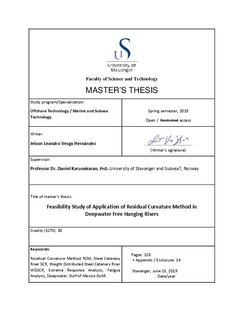| dc.description.abstract | The Offshore Oil and Gas industry has been moving to deeper water and needs to manage production in more extreme conditions. Risers systems are essential components for the transportation of these hydrocarbons from producing subsea wells to topside facilities. To reduce costs and improve safety, it is vital to use the most proper and effective design for these conductor pipes. This thesis proposes a riser configuration to cope with high floater motions in deep water under extreme conditions such as hurricanes, producing from a typical subsea well.
The idea was to modify the geometry of sections of free hanging steel catenary risers to improve its performance by partially decoupling the touch down point of this conductor pipe from floater motions. Residual Curvature Method (RCM) was applied to Steel Catenary Riser (SCR) to achieve this. This method has been applied to control thermal buckling during operation in subsea pipelines. The mentioned technique involves the creation of un-straightened segments or sections with residual curvature in the riser during installation. For ease, any SCR with sections with residual curvature applied will be named as RCSCR.
This project focuses on the Residual Curvature Method applied to a high-pressure line steel catenary riser for 1500m water depth. It was determined that the RCM is a self-limiting process, where the section with residual curvature is able to absorb compressive forces, improve utilization and fatigue in the touch down area of the riser; however, the un-straightened section itself brings more bending moment, utilization and fatigue where it is located, limiting its application. The most optimum configuration for the section, which is made up of 4 subsections, must be applied close to the touch down area and is limited to a curvature of 0.009 m-1 for a 10 inch-internal diameter and 39 mm of wall thickness SCR; with this, obtaining a residual strain of 0.15% in the section. Likewise, it was found that the un-straightened section length that perform best was 180 m which is 12% of the water depth.
A screening of the downward velocities at the hang-off point up in the platform was considered and analyzed, identifying the maximum values for buckling utilization, bending moment and compression, which are main critical responses. SCR with RCM, RCSCR was investigated in terms of the capabilities needed to handle the floater motions. The riser configuration was examined concerning strength, as well as fatigue performances to determine its limitations and merits.
The strength assessment was achieved by using load cases with different sea states, including a typical 3h-winter storm and a hurricane occurring in the Gulf of Mexico. In this study, the sea states were established following JONSWAP wave spectra. The screening approach was based on the downward velocity or heave velocity at the hang-off point, which has been validated to be the principal design criteria for riser integrity. All the checks were performed in accordance with DNV codes.
According to the results for extreme analysis, the SCR studied is restricted to a maximum downward velocity of 2.64 m/s, while the Steel Catenary Riser with Residual Curvature method (RCSCR) can cope with downward velocities up to 2.94 m/s at the hang-off point. Similarly, it was validated that the selected Weight Distributed SCR (WDSCR) configuration for this study can cope with a downward velocity of 3.2 m/s, while the combination of the Residual Curvature Method and WDSCR configuration can improve the coping of downward velocity at the hang-off point up to 4.01 m/s.
On the other hand, the fatigue analysis of the riser configurations was carried out taking into account wave-induced fatigue. In general, the application of the un-straightened section through the Residual Curvature Method extended the life in fatigue of the SCR, increasing its value from 243 years to 599 years in the RCSCR configuration.
The application of the Residual Curvature Method was found to be a viable solution to improve the performance for strength and fatigue of SCR and WDSCR configurations to cope with high motion of floaters. Investigation needs to be done for stability in riser-rotation while in operation, durability and optimization of the un-straightened section. This thesis work showed that, although deep water free hanging risers (SCR and WDSCR) can be limited for coping with large floater motions, economic and innovative solutions can be proven to increase their feasibility to handle higher heave motions in extreme conditions.
All in all, even though it is a self-limiting technique, the application of the Residual Curvature Method reduces stress and fatigue loads in SCR and WDSCR configurations. | nb_NO |
